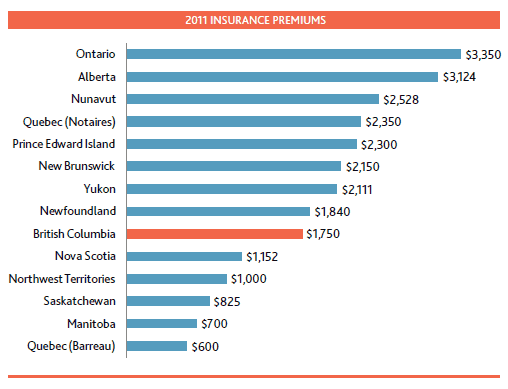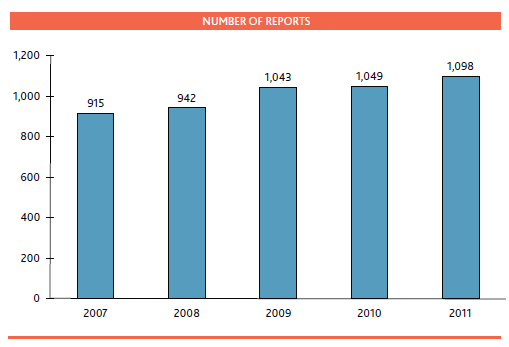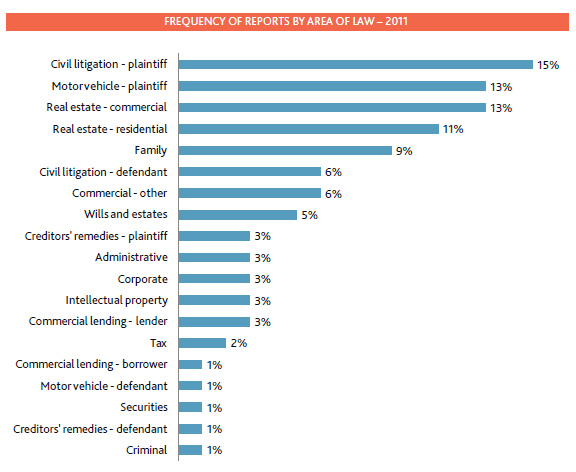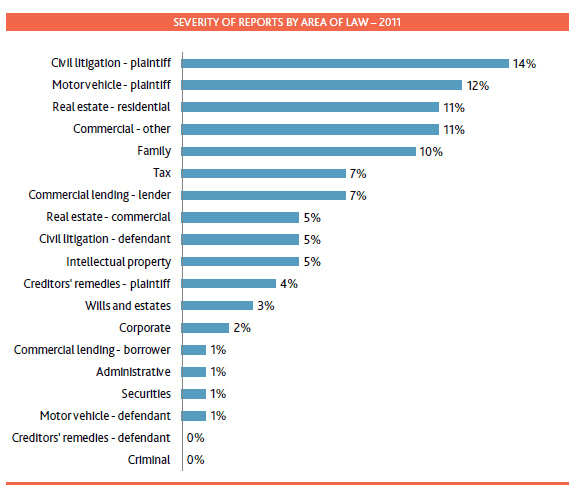This Insurance Issues:
- reports on the 2012 insurance program and policy revisions
- introduces new trust shortage liability (for reliance on fraudulent certified cheques) under Part C of the policy
- reviews statistics on claims and potential claims
- reports on the results of the 2011 claims audit
The Lawyers Insurance Fund manages the Law Society’s insurance program for BC lawyers. The program provides professional liability insurance for negligence (Part A), trust protection coverage for dishonest appropriation (Part B) and, as of January 1, 2012, trust shortage liability insurance for reliance on fraudulent certified cheques (Part C).
Insurance assessment
The insurance fee remains at $1,750 for 2012. While the impact of the recession continues to have some adverse affect on claims activity, effective management and sound investment policies have made it possible to maintain the fee at last year’s level. However, future claims experience and a possible decline in investment values due to continuing financial instability in international markets may require an increase in future years.
The insurance programs in other Canadian jurisdictions continue to face pressure on their reserves and operating income, and the upward trend in fees continues. In fact, lawyers in eight other jurisdictions are facing an increase in their insurance fee over last year. Our fee still remains low, particularly in comparison to the two other larger programs, Ontario and Alberta (see chart on page 2). In addition, our policy is unique in providing insurance for theft under Part B, as well as negligence. As no separate assessment will be levied for Part B in 2012 and the Special Compensation Fund fee drops to $1, the Law Society continues to manage its commitment to protect innocent victims of lawyer theft at no additional cost to lawyers.

Compulsory policy wording
A consolidated policy for 2012 was issued. The policy is enclosed with this mailing and is available on the insurance section of the Law Society’s website, along with all policies and endorsements issued since 1999. The 2012 policy incorporates all changes made since the 2010 consolidated policy was issued. In addition, some coverage is introduced for trust shortages resulting from the “bad cheque” scam. Details of the new Part C: Trust Shortage Liability (for reliance on fraudulent certified cheques) coverage are set out on pages 2-3.The policy now provides three different types of cover, so headings are added that reference Part A: Professional Liability (for negligence), Part B: Trust Protection (for dishonest appropriation) and Part C: Trust Shortage Liability (for reliance on fraudulent certified cheques). The other changes are of a housekeeping nature in relation to the policy as a whole, and Part A. There are no revisions that relate specifically to Part B.
General
An arbitration provision is introduced. Of the 1,000 or so matters reported every year, almost all fall within coverage and issues, if any, are resolved. If they are not, however, the new Condition 10.2 provides that disputes will be determined by arbitration. Insuring Agreement A 2.4 and Conditions 10.1 and 18 also required revision.
Part A: Professional Liability (for negligence)
Related errors
The policy’s $1 million limit of liability has always applied to claims that arise from either a single error or more than one error if the errors are related. The revisions to the definition of “error” in 2009 more clearly specified that errors or mistakes are also related when mistakes occur in relation to the same or similar underlying facts, events, transactions, activities or undertakings. To further clarify “underlying” matters, loan agreements, leases and licences are added to the existing examples of accidents, investment programs or schemes, offerings of ownership interest or debt, corporate reorganizations, tax plans, estates, real estate developments, commercial ventures and litigation matters.
Acting merely as a bailiee
Lawyers may hold personal property belonging to others in relation to legal or other professional services being provided. Very rarely, someone will choose a lawyer, rather than a safety deposit box, to protect personal property. This is not a risk to which the policy is intended to respond. As a lawyer possessing property is in a relationship of bailment with the owner, the policy now specifically provides that a lawyer who is acting merely as a bailee is not providing professional services.
Cyber risks
Technology is dramatically changing how lawyers do business. The transfer from paper-based to electronic systems for data storage and processing has brought tremendous opportunities, but also potential new risks in terms of data breaches. A data breach might result in the theft of a client’s identity, or confidential information advantageous to a competitor. Whether a third party manages to obtain access by hacking a server or stealing a laptop, any claims that might arise are not ones to which the policy responds as they do not arise out of the lawyer’s negligent provision of legal services. A new Exclusion 12 clarifies that claims arising out of or connected to the collection, use and/or disclosure of any information by a third party are excluded. Lawyers should take appropriate steps to safeguard confidential information, whether paper or electronic, and ensure any professional or legal obligations relating to protecting information are met.
Commercial insurance is also available to protect against these risks. Due diligence and risk management suggestions about the use of technology and third party data storage and processing are set out in the Law Society’s cloud computing report (go to Publications > Committee and Task Force Reports > Records/Filing/Technology at lawsociety.bc.ca). The Law Society Rules are also undergoing revision, as recommended in that report, and a related practice checklist will be created.
Trust shortages
Professional liability insurance (Part A) does not respond to claims that fall within trust protection coverage (Part B) or trust shortage liability insurance (Part C). Exclusion 11, now Exclusion 11.1, and a new Exclusion 11.2 clarify that Part A does not respond to claims related to either dishonest appropriations or trust shortages caused by dishonesty or fraud.
Part C: Trust shortage liability (for reliance on fraudulent certified cheques)
In the “bad cheque” scam, fraudsters pose as real clients, with real legal matters, to dupe a lawyer into depositing what appears to be a genuine certified cheque or similar instrument into trust. On the strength of that deposit, the lawyer pays good funds out of trust. As the instrument deposited was a fake, the lawyer is liable in debt to any clients whose funds are now depleted and, if the account is overdrawn, the bank. There is no negligent provision of legal services giving rise to a claim for damages that would trigger coverage under Part A. However, with the introduction of trust shortage liability insurance under Part C, some coverage is now available.
With due diligence, the bad cheque risk can be avoided or eliminated. Part C is therefore tailored to encourage lawyers to continue with the vigilance that, to date, has ensured very few lawyers are actually caught. Sub-limits (lower claim limits), a profession-wide aggregate (a cap on payments), a higher deductible and required compliance with the client identification and verification rules (Rules 3-91 to 3-102) will reduce the risk to the fund. Lawyers will also bear a significant portion of any trust shortage personally. To assist lawyers, extensive risk management material relating to the scam is in the “fraud alerts” section of the Law Society website. The Law Society also emails fraud alerts to the profession when new variations are discovered, and maintains a web page list of names and documents used by fraudsters in BC. Lawyers are asked to report any new potential scams and fraudsters to Practice Advisor Barbara Buchanan (bbuchanan@lsbc.org or 604.697.5816). Of course, if you are actually caught, you will need to report to the Lawyers Insurance Fund immediately.
Policy provisions
The main policy provisions relating to the new Part C cover are summarized below. These summaries are intended for guidance only, as the policy wording ultimately governs any Part C claim.
What losses are covered
Coverage is available to pay a trust shortage provided that:
- the lawyer is operating a trust account in accordance with the Law Society Rules;
- a payment to a third party creates an unintended shortage in client funds held in that trust account; and
- the shortage is the result of the deposit into trust of what purports, appears and the lawyer believes to be a genuine certified cheque, bank draft, credit union official cheque, law firm trust cheque or money order that ultimately proves to be counterfeit, forged or materially altered. There is no coverage for overdrafts.
Limits
There is a limit of $500,000 for each claim. That limit is subject to three annual aggregate limits: $500,000 for each lawyer; $500,000 for each firm; and $2 million for the entire profession. This means that there is a maximum of $500,000 available in any calendar year to pay all Part C claims on behalf of any one lawyer or any one firm. As a result, if a lawyer or firm falls victim to several bad cheque scams in a year, no more than $500,000 is available to pay those claims regardless of the total amount of any resulting shortages. Through the profession-wide aggregate, up to $2 million can be paid in any calendar year for all claims reported by BC lawyers, subject to the per lawyer and firm limits.
All limits are inclusive of both indemnity payments made to replenish the trust shortage, and expense payments. Part C payments also reduce the annual aggregate under Part A.
Deductible
The deductible is 35% of the client trust fund shortage, reduced by the amount of any overdraft paid. Reducing the deductible by the amount of any overdraft offers some financial relief to lawyers with insufficient funds in trust at the relevant time to cover the amount paid out. By way of example, assume that a lawyer deposits a bad cheque for $150,000 and, relying on the bad cheque, pays that same amount out of trust. If the lawyer holds:
- $300,000 in client funds in trust, the payment will create a trust shortage of $150,000. The lawyer will pay a deductible of $52,500 (35% of the $150,000 shortage);
- $70,000 in client funds in trust, the payment will create a trust shortage of $70,000 and an overdraft of $80,000.The lawyer will not pay the deductible of $24,500 (35% of the $70,000 shortage) as it is reduced to zero by the $80,000 overdraft the lawyer must pay.
Other requirements
The Law Society’s client identification and verification rules oblige a lawyer to comply with certain procedures. As compliance may well prevent a lawyer falling victim to the scam, coverage is lost if the rules are not followed. Coverage is also excluded if the claim is connected to or arises out of the wrongful or unlawful conduct of a firm employee or contractor, or occurs before January 1, 2012.
Rule 3-66(1) obligates a lawyer who discovers a trust shortage to immediately pay enough funds into the account to eliminate the shortage. In keeping with a lawyer’s obligation in this regard, Part C payments will only be made after the lawyer has replenished the trust account as required.
A review of claim and potential claim reports
Part A (negligence)
The chart below shows the number of reports over the past five years. Reports include both claims and potential claims. The numbers continue to show consistency with our previous experience of increased claims activity for some years following a recession.

The two charts on page 5 provide more information about the specific claims experience in 2011 by area of law. The first shows the percentage of reports generated by the different areas of practice. As in past years, Civil litigation – plaintiff and Motor vehicle – plaintiff continue to account for a significant percentage of reports, likely reflecting a higher exposure to missing a limitation or deadline. The second shows the areas of practice according to the actual or expected cost of reports made in 2011. It appears that the impact of the economic downturn continues to be felt, with the conveyancing and commercial areas of law accounting for almost half of all dollars spent or reserved.


Part B (theft)
Since this coverage was introduced in May 2004, total compensation of $390,000 has been paid relating to 48 claims involving 14 different lawyers. On average, we pay Part B claims on behalf of two lawyers each year. Given the 7,500 or so lawyers in private practice over the past seven years, our claims experience continues to demonstrate the very small number of lawyers involved in misappropriations.
In 2011, four claims were paid on behalf of three different lawyers, totaling approximately $21,200. Details of these claims follow:
- David Blinkhorn:* A payment of $16,561 was made based on the circumstances described in paragraph [3] (12) of Law Society of BC v. Blinkhorn, 2009 LSBC 24. Blinkhorn represented a minor in a claim for injuries suffered in a motor vehicle accident and misappropriated the settlement funds. Payments of $11,235 and $40,746 were previously made on behalf of Blinkhorn based on the circumstances described in paragraphs [3](13) and [3] (2) of that decision. For more details, see the hearing reports on the Law Society website.
- Two claims totaling $1,220 were paid on behalf of a lawyer. In both, the lawyer acted for the purchasers in residential real estate transactions. In the first, the lawyer misappropriated a portion of the purchase funds he had undertaken to pay a strata management company. In the second, the lawyer misappropriated excess mortgage proceeds received from the client’s lender. A total of $168,122 for all years has now been paid on behalf of this lawyer.
-
A payment of $3,420 was made on behalf of a lawyer who accepted and kept a retainer to assist the client in a criminal matter. The lawyer provided no services to justify the amount kept.
* The Law Society Rules permit disclosure of the name of a lawyer or former lawyer and the circumstances of Part B claims when a discipline hearing panel finds misappropriation.
None of the lawyers involved remain members of the Law Society, and all are obliged to reimburse the Society for the amounts paid on their behalf.
In 2011, we recovered $4,300 from one lawyer on whose behalf we had paid Part B claims. We also sued another former member for amounts paid under Part B, although we have not yet made any recovery. Other matters reported as potential claims did not develop into claims, and other claims were withdrawn or abandoned by the claimants or did not involve misappropriations. In the remaining reports, the claimants are not actively pursuing a part B claim, or we are not yet in a position to determine if the claim is properly payable.
Lawyers Insurance Fund 2011 audit
… we found a very experienced, skilled, creative and motivated staff and management performing tremendously and at a high level of effectiveness. The goal of resolving claims in a cost-effective manner balancing the interests of the insured lawyer, the claimant and the Law Society members is clearly being met – or exceeded – by this collegial and passionate group.
This is the summary of the overall results of the most recent independent claims audit of the Lawyers Insurance Fund. A claims audit, required to assist the Benchers in monitoring the insurance operations, is conducted every five years by auditors experienced in professional liability claims. The audit helps determine whether the Lawyers Insurance Fund is meeting its objective of resolving claims in an appropriate and cost-effective manner.
In response to a request for proposals to conduct the 2011 audit, the Audit Committee selected Carter L. Hampton and William Bogaert, two US attorneys experienced in both insurance industry and lawyer malpractice defence work. The audit included a detailed evaluation of internal processes and a formal audit of a representative selection of files. The results of the audit were extremely positive in relation to all of the aspects reviewed, from quality control measures to claim repairs. In addition to the summary quoted above, the auditors also noted:
Having a complete staff of experienced, thoughtful and innovative claims counsel operating as a cohesive group with very low turnover, is an enormous benefit to the Lawyers Insurance Fund and the members of the [Law] Society.
… the materials we have reviewed strongly evidence the desire of the Lawyers Insurance Fund management for continuous improvement and excellence, to provide even better service to its insureds and to be even more cost effective in its claims handling and resolution.
A review of all comments provided [in the service evaluation forms] in the last year demonstrated the exceptional service given to insured lawyers and the high esteem of the program in the eyes of the profession. We cannot adequately express how impressed we were with this final follow-up to a claim. This should be the service industry standard that all should follow.
2012 and beyond
The practice of law is challenging. And the risks inherent in practice are exacerbated as the changing world impacts lawyers directly, particularly in relation to the economic and technological environment. Parts of the economy have improved, others remain stagnant, and it is impossible to predict how volatility in global markets might affect us in BC. Technology offers real benefits to lawyers, but also potential traps. The bad cheque scam, for instance, could hardly have developed without the internet.
As evidenced by the latest audit, the Lawyers Insurance Fund works hard to manage claims cost-effectively. However, implementation of risk management strategies by lawyers remains the single most effective way of reducing the cost of claims to lawyers.